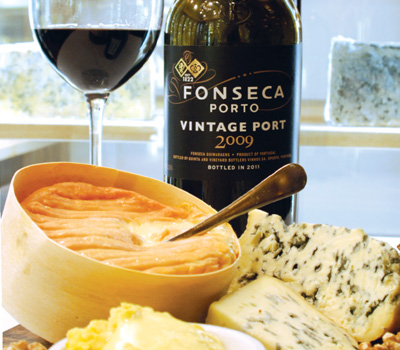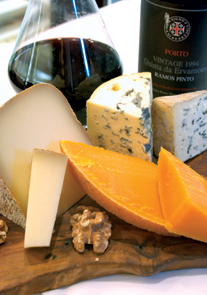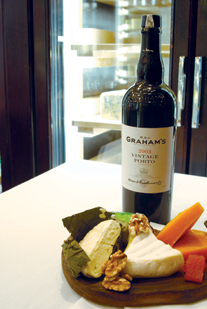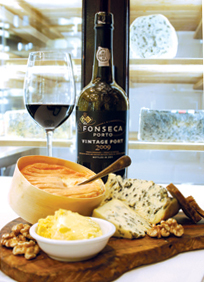Chantal Girerd opened the cheese cave at Artisanal Bistro ten years ago this past April.


That’s where Girerd comes in. A native of France’s Haut Savoie, she can tell by a touch when an Epoisses is reaching the best moment. While other credentialled experts at Artisanal Bistro have come and gone, Girerd has been my go-to fromager for years, along with one of her protègès, Charles Mahal. Recently I asked Girerd and Mahal to select a range of French cheeses to match three ages of Vintage Port: A youthful Fonseca 2009, a powerful Graham’s 2003 and a mature Ramos Pinto 1994. We agreed on one ground rule: nothing too similar to the standards for Vintage Port, Stilton and Portugal’s Queijo de Serra.
As I decanted the Ports in their cheese cave, Mahal described how he’d gone back through his notes to find some non-traditional pairings. Then we set out to find the most delicious matches for each of the Ports.


Abbaye de Belloc, Mimolette, Fourme d’Ambert
From a vineyard in the arid, eastern reaches of the Douro Superior, the ’94 Ramos Pinto has aged into an elegant wine with fresh, plummy sweetness.
When it meets with a wedge of Abbaye de Belloc, the sheep’s milk cheese from the Pyrenees has a creamy, almost smoky richness to bring out the mineral detail in the wine’s tannins, pointing up the schist in the wine as well as a bright strawberry note.
Mahal describes the Mimolette, a hard, tawny-colored round of cow’s milk cheese, as a little bit more sour and subtly fruity than traditional aged Gouda, with a spicy character adding some bite to the caramel notes of the cheese. It plays well with the mature Port, its caramel notes lingering on the Port’s own. And Mahal points out a saltiness in the cheese that also compliments the Port, a salt lick to cut the sweetness.
For a blue, Girerd and Mahal wanted one that was not too assertive, and chose a Fourme d’Ambert, a gentle blue that coats the palate with buttery richness. “This is a blue that doesn’t show off,” Mahal says. “It doesn’t have super tartness or super acidity; it’s not going to clash.” In fact, it fattens up the Port, adding complexity and expanding on the luxurious textures in the wine. It’s a mouthwatering match. “Sexy,” said Susan Numeroff, Brennan’s partner in the restaurant who’d stopped in for a taste.


Préféré de Nos Montagnes, Banon, Mimolette
The heat of the 2003 vintage created concentrated Port wines with powerful tannins, a character balanced by Graham’s fruit-forward style. Like other 2003s, this wine is in an adolescent phase, emphasizing tannin and black fruit.
To deal with its aggressiveness, Mahal pulls out a Préféré de Nos Montagne, a soft and buttery cow’s milk cheese without any animal funk to it, but instead a flavor Mahal describes as “scallop-like or kelpy.” It works well with the Port, the wine’s edges connecting and aligning with the softer edges in the cheese.
Banon is a cow’s milk cheese wrapped in chestnut leaves that were marinated in eau-de-vie. The flavors range from woodsy to funky the closer you get to the edge of the cheese. That bit of autumnal decay is brightened by the Graham’s, which, in the process, highlights the fruitiness of the wine.
But the Mimolette is perhaps the best match here. “Port wine goes well with a chocolate taste,” says Girerd of the bass notes in the Mimolette. “It’s like a French Gouda—candy with the Port.”


Langrès, Epoisses, Banon
As recently as ten years ago, it would have been somewhat painful to drink Vintage Porto on release. Between more sophisticated viticulture and better brandy, many wines are now supple and delicious at two years of age—even a wine as powerfully structured at this Fonseca. There’s enough vibrant red fruit flavor to last beyond all the youthful, peppery intensity.
That intensity calls for high butterfat, whether in a mild Langrès, its rind washed with marc de Champagne, or a saltier, stinkier Epoisses from the Côte d’Or, washed in brine and brandy. In fact, the 2009 is the only one of the three wines that can handle these two cheeses: The fruitiness of the Fonseca doesn’t give way to the richness of the cheeses. “Sometimes dessert wines go sour with Epoisses,” Mahal finds. “The Fonseca is moving closer to a red wine with the cheese.” The saltiness of the Epoisses in particular contrasts the juicy blueberry freshness in the Port.
The Banon changes the wine completely: It brings out the bass notes in the fruit and lengthens the flavors. “I thought the Banon would be so bad I’d be embarrassed, or it would do something crazy,” Mahal admitted. “These are very mature flavors in the cheese. If someone got a younger Banon, I don’t know if it would work as well.” It’s an important point to raise with your favorite fromager if you decide to try this at home.
Artisanal Fromagerie • Bistro • Wine Bar, 2 Park Avenue, NYC, 212-725-8585, artisanalbistro.com
This story was featured in W&S December 2011.
photos by Tara Van Der Linden
Joshua Greene is the editor and publisher of Wine & Spirits magazine.
This story appears in the print issue of December 2011.
Like what you read? Subscribe today.
















